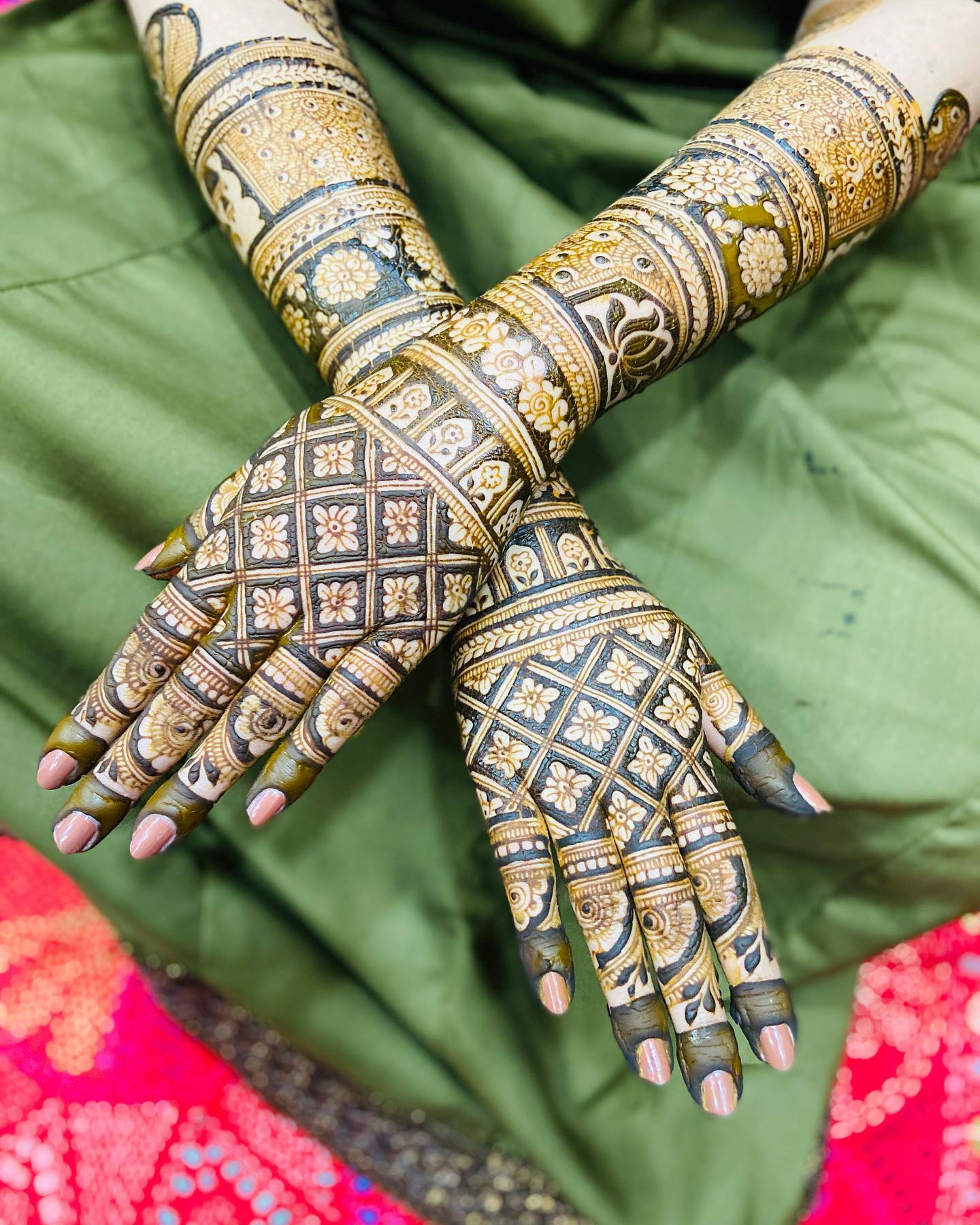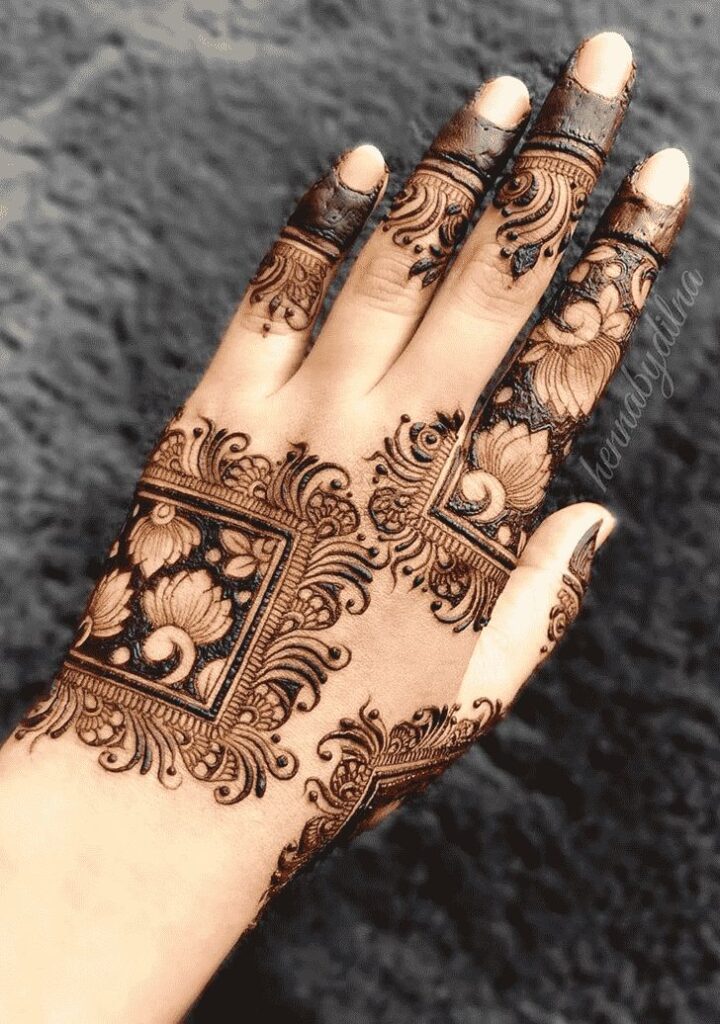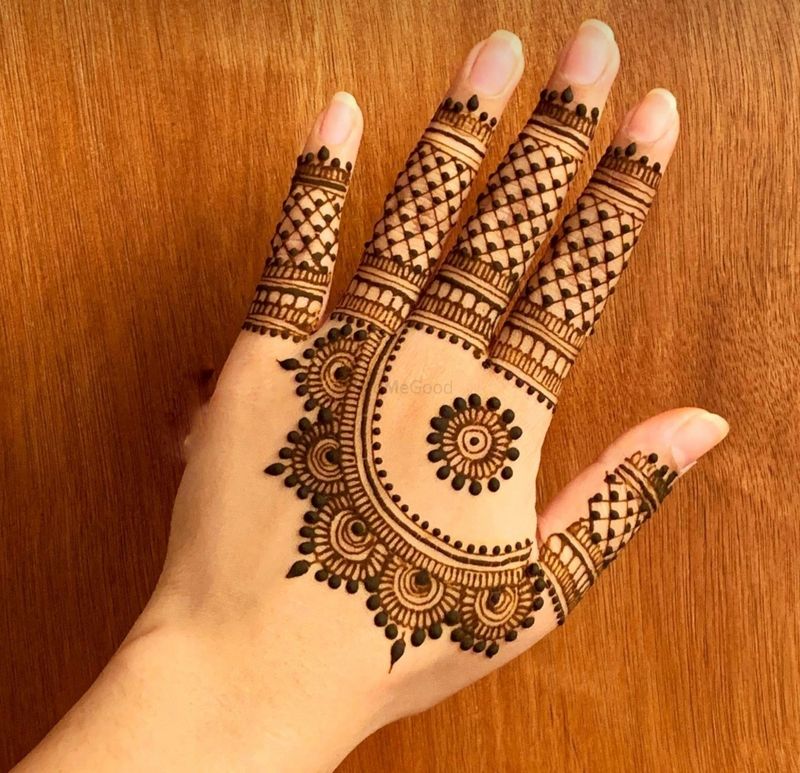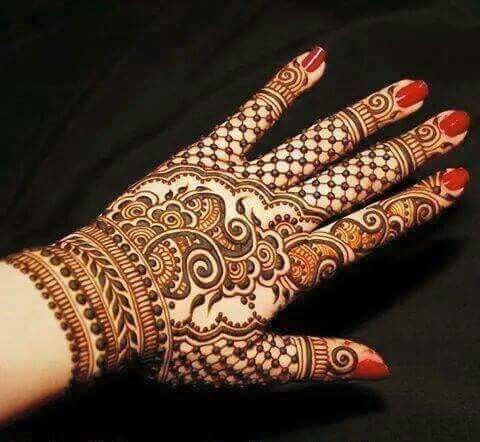Table of Contents
Mehndi, also known as henna, is a centuries-old form of body art that has deep cultural roots in many parts of South Asia, the Middle East, and Africa. Traditionally, it is applied to the hands and feet, often for celebratory occasions like weddings, festivals, and religious ceremonies. In recent years, however, royal checks mehndi design has evolved to include a broader range of designs. With new patterns emerging to suit contemporary tastes. One of the most intriguing and popular patterns is the check mehndi design, which is both traditional and modern, minimalist yet complex.
Among various patterns in Mehndi, the “check” or “checkerboard” style stands out for its symmetry and visual appeal. It adds a geometric elegance to traditional floral and paisley motifs, making it a versatile choice for modern henna enthusiasts. While check Mehndi designs are common for the palms, they have also become highly popular for the back, offering a unique canvas for intricate work. In this blog, we will explore check Back Check Mehndi Design particularly for the back, delving into their origins, significance, and how they add to the beauty of contemporary henna art.

Understanding Check Mehndi Design
The check Mehndi design, as the name suggests, involves a grid or checkerboard pattern incorporated into henna art. These grids can vary in size and intricacy, forming the framework for more elaborate motifs such as flowers, vines, leaves, and paisleys. The checkerboard design creates a visually pleasing symmetry, offering a contrast to the more organic. And flowing patterns commonly associated with traditional Mehndi.
Variations in Check Mehndi Design:
Traditional Checkerboard: This basic form involves creating a series of squares across the design area. These squares can either be left blank or filled with intricate detailing such as dots, lines, or small florals.

Floral Checks: Instead of filling each square with simple patterns, this style incorporates floral motifs within each box of the checkerboard. It adds depth and femininity to the design, making it perfect for bridal Mehndi.

Criss-Cross Grid: This variation includes diagonal lines intersecting each other to form a more dynamic and complex grid, creating a three-dimensional effect. This design is perfect for those who want a modern twist on traditional Mehndi.

Paisley in Checks: Combining paisleys, a popular motif in traditional henna, with the grid pattern offers a fusion of old and new. Each square may hold a mini-paisley design, offering an intricate yet clean look.

Geometric Symmetry: Some Mehndi artists take the check pattern to the next level by adding mathematical precision. Creating complex geometrical designs like interlocking grids and tessellations within the grid squares.

Why Check Mehndi Designs for the Back?
The back offers a larger canvas compared to the hands or feet, allowing for more intricate and extensive designs. While the hands are often reserved for bridal or formal occasions, the back has become a popular space for casual and experimental Mehndi, including check designs. Here are a few reasons why check Mehndi designs are perfect for the back:
Bold and Symmetrical: The structured nature of check Mehndi design creates a bold statement, which is ideal for the back. The symmetry of the design makes it visually appealing and ensures it stands out on a larger canvas like the back.
Versatility: Whether you prefer minimalistic designs or something more complex, check patterns offer versatility. You can keep it simple with large, unfilled grids or go intricate by filling each square with detailed motifs.
Balanced Aesthetics: Check Mehndi designs for the back provide a perfect balance between traditional motifs and modern geometry. The checkerboard creates a neat structure, and when combined with more organic designs like flowers or paisleys, it offers a balanced, aesthetically pleasing look.
Customization: The larger space allows for more room to customize the design according to personal preference. You can choose a design that flows from the shoulder blades down the spine or spreads out across the upper back.
Durability: Mehndi on the back tends to last longer than on the palms, where the skin is constantly exposed to water and soap. This ensures that your check design remains intact for a more extended period, allowing you to flaunt your Mehndi for days.

Popular Check Mehndi Designs for the Back
The back provides a creative space for Mehndi artists to explore a variety of check patterns, combining them with other elements to create visually stunning designs. Below are some of the most popular check Mehndi designs for the back:
Simple Grid with Floral Accents:
A minimalist approach, this design features a clean grid that spans across the back with small floral accents placed sporadically within the squares. The simplicity of the grid contrasts with the soft, natural look of the flowers, creating a modern yet delicate design.

Checkerboard Spine Design:
For a bolder look, a check pattern can be drawn along the spine, with larger squares placed at the top and gradually getting smaller toward the base of the back. This creates a cascading effect, making it visually striking. Some variations of this design include filling the squares with intricate paisleys or leaves.

Full Back Check Mehndi Design:
For those who want a more elaborate design, a full-back check Mehndi can be created. In this style, the check pattern covers a larger portion of the back, with each square housing a different intricate design. You can add paisleys, mandalas, flowers, or geometric shapes within each square. This gives the design a patchwork feel, making it one of the most creative and customizable options.

Geometric Mandala with Check Pattern:
A large mandala can serve as the centerpiece on the upper back, with a check pattern radiating outwards. This design combines the spiritual and symmetrical elements of the mandala with the structured. the modern feel of the check pattern, creating a visually appealing blend of traditional and contemporary styles.

Checkerboard with Peacocks:
Peacocks are a common motif in Indian Mehndi, symbolizing beauty and grace. Incorporating them into a check Mehndi design adds a touch of elegance. The peacock design can be placed at the top center of the back, with a checkerboard grid flowing downwards. This design is perfect for bridal occasions or festive events.

How to Choose the Right Check Mehndi Design for Your Back
When choosing a check Mehndi design for your back, consider the following factors:
Event or Occasion: For formal occasions such as weddings, more elaborate and detailed designs are appropriate, such as a full-back checkerboard with intricate fillings. For casual events, a simpler grid with minimal detailing works best.
Personal Style: If you prefer a modern look, opt for geometric and minimalist check patterns. If you want a more traditional design, incorporate floral or paisley motifs within the check pattern.
Size of the Design: Consider the size of the design based on the amount of skin you want to cover. A large, full-back design is more dramatic, while a smaller spine or upper-back design is subtler.
Artist’s Expertise: Make sure to choose a professional Mehndi artist experienced in check designs. As the pattern requires precision and symmetry to look its best.
Origins and Cultural Significance of Mehndi
Before delving into the specifics of check Mehndi designs, it is essential to understand the cultural significance of Mehndi itself. The practice of applying henna can be traced back thousands of years. Ancient cultures used henna as a form of body decoration, religious symbolism, and even as a medicinal plant. In Indian, Pakistani, and Middle Eastern cultures, Mehndi is an essential element in weddings. And religious festivals such as Eid and Diwali.
Traditionally, Mehndi symbolizes joy, beauty, and spiritual awakening. The bride’s intricate Mehndi design is not just an aesthetic choice; it signifies love, prosperity, and protection. In some cultures, the darker the Mehndi stains on a bride’s hands, the stronger her marital bond is believed to be. While these beliefs are steeped in tradition, modern Mehndi is more than just cultural symbolism. It has evolved into a form of self-expression, fashion, and art.

How long does it last?
Mehndi (henna) typically lasts 1 to 3 weeks, depending on several factors such as skin type, care, and the quality of the henna used. Here’s a breakdown of the key factors that influence how long mehndi designs last:
Henna Quality
- Natural henna: Pure, natural henna made from the leaves of the henna plant tends to last longer and gives a rich, dark stain. It usually lasts around 1 to 3 weeks.
- Pre-mixed or chemical-based henna: Some pre-mixed henna cones may contain chemicals or dyes, which can produce quicker but shorter-lasting results. They typically fade faster, sometimes within 7 to 10 days.
Skin Type
- Oily skin: Mehndi may fade more quickly on oily skin. Because the oil can prevent proper absorption of the henna into the skin.
- Dry skin: Mehndi tends to last longer on dry skin as the skin absorbs the henna better. It is resulting in a more long-lasting stain.
Body Location
- Hands and feet: Henna stains on the palms and soles of the feet usually last longer (around 2 to 3 weeks). Due to thicker skin and better dye absorption.
- Back and other areas: Henna on the back or other body areas tends to fade faster (1 to 2 weeks). Because the skin in these areas is thinner and may not absorb the henna as deeply.
Aftercare
- Moisturizing: Keeping the skin moisturized with natural oils (like coconut or olive oil). After the mehndi is applied can help extend its life. Avoid chemical-based moisturizers.
- Avoiding water exposure: Frequent washing or exposure to water (especially hot water or soap). It can cause the design to fade more quickly. Limiting water exposure can help it last longer.
Henna Application
- Duration of application: The longer the henna paste stays on the skin (typically 6 to 8 hours or overnight), the deeper the stain will be, leading to a longer-lasting design.
- Use of fixatives: Applying lemon juice mixed with sugar on the henna helps darken the stain and increases its longevity.
By following proper aftercare, you can help your mehndi design last closer to the 3-week mark.

Conclusion
Check Mehndi designs for the back combine tradition with modern aesthetics, offering a versatile and striking option for those looking to make a statement. Whether you’re preparing for a wedding, a festival, or simply want to experiment with henna body art, check Mehndi offers endless possibilities for creativity. The back provides a perfect canvas for this symmetrical and bold design, allowing for more extensive and intricate patterns.
FAQ:
What is a Check Mehndi Design?
A check Mehndi design features a grid or checkerboard pattern, where squares or rectangles are drawn across the skin. These grids can be left blank or filled with intricate designs like florals, paisleys, dots, or geometric shapes. The design adds a modern and structured touch to traditional Mehndi art.
Why is Check Mehndi Design popular for the back?
The back offers a larger canvas, allowing for more detailed and expansive Mehndi designs. Check Mehndi designs for the back are popular because they provide symmetry and structure, making the artwork visually striking. The design can be customized to fit the natural curves of the back, and its larger size helps it stand out, making it perfect for occasions like weddings or festivals.
How long does Check Mehndi Design last on the back?
Typically, henna on the back lasts about 1 to 2 weeks. It may fade faster than on the hands or feet due to the thinner skin and frequent contact with clothing. With proper aftercare, such as moisturizing and limiting exposure to water, the design can last longer.
Can I customize my Check Mehndi Design?
Absolutely! Check Mehndi designs are highly customizable. You can choose the size and shape of the grid, and decide whether to leave the squares blank or fill them with intricate details. You can also incorporate other traditional motifs like paisleys, mandalas, or florals to personalize the design.
Is Check Mehndi Design suitable for all occasions?
Yes, check Mehndi designs can be adapted for both formal and casual occasions. For formal events like weddings or festivals, the design can be elaborate with intricate fillings and larger coverage. For casual or personal occasions, you can opt for simpler, minimalist grids that still Is Check Mehndi Design difficult to apply?
It can be a bit challenging, as the design requires precision and symmetry to create clean and sharp lines for the grid. An experienced Mehndi artist will be able to execute the check pattern smoothly, ensuring that the grids are even and the detailing within each square is intricate and well-balanced.
What should I wear while getting a back Check Mehndi Design?
Wear a backless or loose-fitting top that exposes the area where you want the design applied. This allows the artist to have easy access to your back and ensures that the design remains undisturbed while it dries. After the application, make sure your clothing doesn’t rub against the design to prevent smudging.
How do I care for my Check Mehndi Design on my back?
After application, allow the henna to dry and leave it on for as long as possible, ideally overnight. After scraping off the dried paste, avoid washing the area with soap for at least 24 hours. You can apply a bit of oil to the design to help deepen the color. Avoid activities that cause excessive sweating or friction on the back, as these can cause the design to fade faster.
Best Wedding Dress Codes For Guests – The Complete Guide For Guests!


